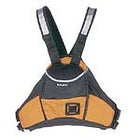You’re quite right, Charles, U.S.-made PFDs aren’t suitable in Canadian waters. That’s because Canada has re-formulated its coastal waters, adding a molecule of a new element called Labattbeerneum. It gives the water a nice, foamy head, but in which U.S. flotation devices tend to sink. (Just kidding. Alert American readers will realize there is no such element as Labattbeerneum…)
 Orbit Tour
Orbit Tour
Actually, there are some minor (albeit less facetious) differences between U.S. and Canadian PFDs. In part, it’s strictly cosmetic, such as the fact Canadians measure the flotation power of their PFDs in newtons of buoyancy, while we in the United States use pounds. Your Canadian authorities are also a little more stringent about materials testing, particularly in terms of how the strength of certain fabrics can be compromised through the dyeing process.
That said, several U.S.-made PFDs are sold in Canada, including a half-dozen models from Kokatat. For example, their Orbit Tour ($155 Canadian; www.kokatat.com), which would be perfectly suitable for sea kayaking. Additionally, to allay any concerns about its cross-border compatibility, it’s approved by the Canadian government’s rubber-stampers.
As for a hydration device, why not stick a water bottle under a deck bungee? Costs $5, and works just fine. Otherwise, today’s PFDs are so low-profile that most any hydration pack will fit over just fine. The MEC Marathon leaps to mind ($50 Canadian; www.mec.ca).


